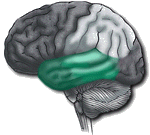Temporal Lobes – Temporal Cortex – Processing, Emotions and Memory
Temporal Lobes – Involved with Processing, Emotions and Memory
Call me at 800-992-9447
The temporal lobes contain the brain’s auditory receptive area. They also contain the areas for expressed behavior, receptive speech and information retrieval. The temporal lobes lie below the frontal lobes and the parietal lobes. They are highlighted in green on the picture to the right. The frontal lobes show as charcoal and the parietal lobes as white. The temporal lobes are separated from the lobes above it by the lateral cerebral fissure. This is also known as the Sylvan fissure.
Temporal Lobes Role In Auditory Processing
Much of the temporal lobes are concerned with hearing and related functions. Hearing related memory is here. Complicated auditory and perceptual information is stored in the temporal lobes. Aspects of music are stored here. The pathways for auditory information to the rest of the brain lie here. The temporal lobes also play an important role in attention to auditory input.
It is believed that the right temporal lobe plays a role in spatial, non-verbal and abstract reasoning. The right temporal lobe plays a role in naming of objects and recognition of facial expressions.
These lobes contain key components of the limbic system.
Function in Memory
Many of the regions of the temporal lobes are critical for learning and memory. The middle portion of these lobes are important for the learning of new information. The medial portion of the temporal lobes contain the hippocampus, the critical brain structure for short term memory, the brain’s save button. The hippocampus combines with the entrohinal, perirhinal cortices and parahippocampal gyrus, to form the hippocampal complex. The hippocampal complex has direct connections to the entire brain.
Temporal Lobes and Emotion
Contained within these lobes is the amygdala. The amygdala is the brain’s panic button and has a more specific function in mammals that survive based upon a “fight or flight” response. The amygdala attaches an emotional layer to sensory input, such as the sense that a lion is about to attack. Other limbic structures overlap into areas of the temporal lobes.
Next – Parietal and Occipital Lobes





Living with a brain tumour – Sue’s story – Danggle Markets
Aug 17, 2018 @ 13:14:46
[…] days and bad days. It’s changed my personality, which is probably because the tumour is near my temporal lobe, where emotions are […]